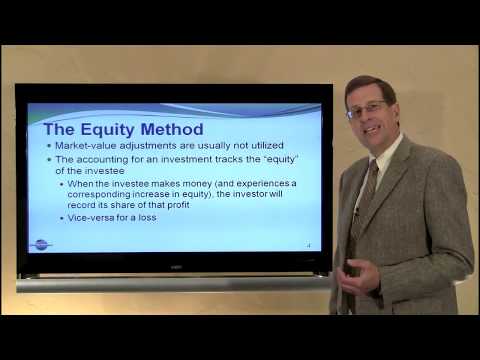16.3: Equity Method
- Page ID
- 26285
The equity method for long-term investments of between 20 percent and 50 percent
When a company (the investor) purchases between 20% and 50% of the outstanding stock of another company (the investee) as a long-term investment, the purchasing company is said to have significant influence over the investee company. In certain cases, a company may have significant influence even when its investment is less than 20%. In either situation, the investor must account for the investment under the equity method.
When using the equity method in accounting for stock investments, the investor company must recognize its share of the investee company’s income, regardless of whether or not it receives dividends. The logic behind this treatment is that the investor company may exercise influence over the declaration of dividends and thereby manipulate its own income by influencing the investee’s decision to declare (or not declare) dividends.
Thus, when the investee reports income or losses, the investor company must recognize its share of the investee’s income or losses. For example, assume that Tone Company (the investor) owns 30% of Dutch Company (the investee) and Dutch reports $50,000 net income in the current year. Under the equity method, Tone makes the following entry as of the end of year:
| Investment in Dutch Company | Debit 15,000 | Credit |
| Income from Dutch Company ($50,000 x 0.30) | 15,000 | |
| To record 30% of Dutch Company’s Net Income. |
The $15,000 income from Dutch would be reported on Tone’s income statement. The investment account is also increased by $15,000.
If the investee incurs a loss, the investor company debits a loss account and credits the investment account for the investor’s share of the loss. For example, assume Dutch incurs a loss of $10,000 during the year. Since it still owns 30% of Dutch, Tone records its share of the loss as follows:
| Loss from Dutch Company ($10,000 x 0.30) | 3,000 | |
| Investment in Dutch Company | 3,000 | |
| To recognize 30% of Dutch Company’s loss. |
Tone would report the $3,000 loss on its income statement. The $3,000 credit reduces Tone’s equity in the investee. Furthermore, because dividends are a distribution of income to the owners of the corporation, if Dutch declares and pays $20,000 in dividends, this entry would also be required for Tone:
| Cash | 6,000 | |
| Investment in Dutch Company ($20,000 x 0.30) | 6,000 | |
| To record receipt of 30% of dividends paid by Dutch Company. |
Under the equity method just illustrated, the Investment in the Dutch Company account always reflects Tone’s 30% interest in the net assets of Dutch.
- Accounting Principles: A Business Perspective. Authored by: James Don Edwards, University of Georgia & Roger H. Hermanson, Georgia State University. Provided by: Endeavour International Corporation. Project: The Global Text Project. License: CC BY: Attribution
- 9 - The Equity Method of Accounting. Authored by: Larry Walther. Located at: youtu.be/EIoeMEVkoUI. License: All Rights Reserved. License Terms: Standard YouTube License


